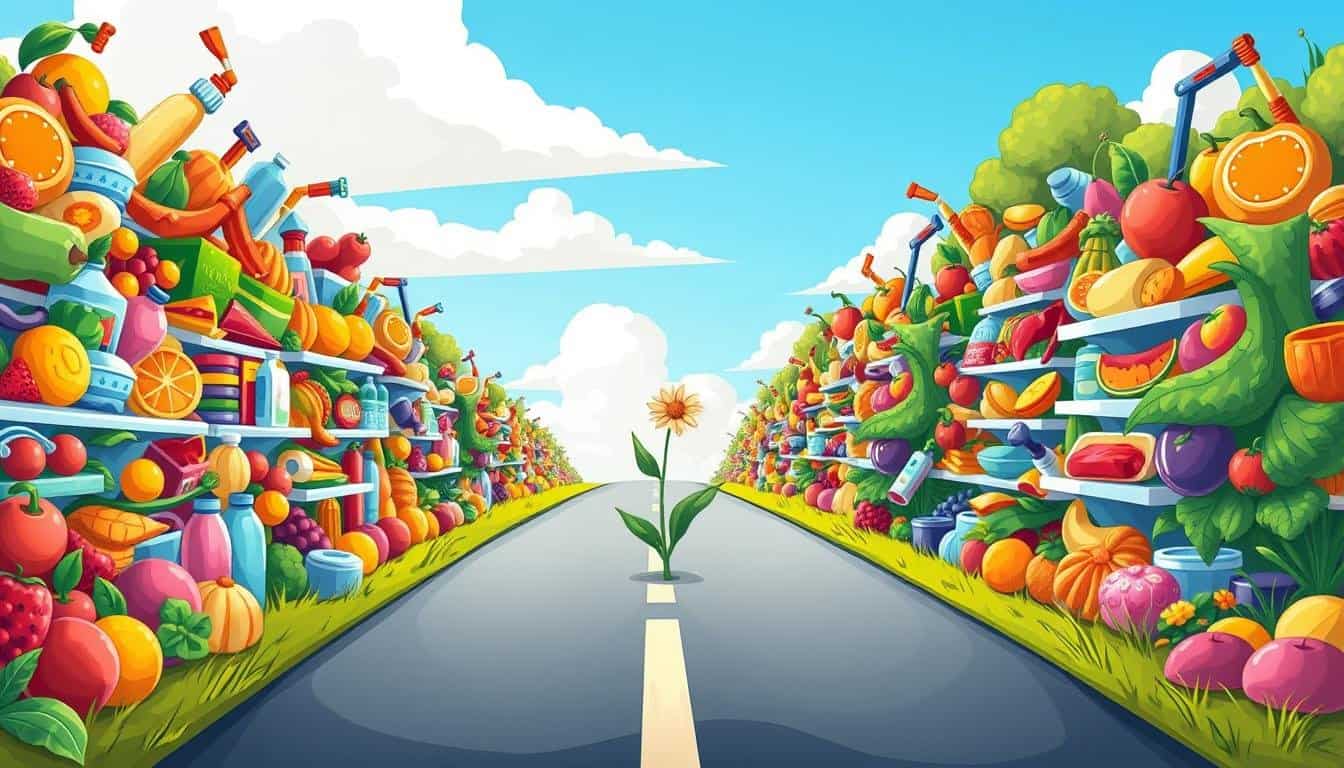Paradox of Choice: Less Is More for Decision-Making
Have you ever thought about why having more choices doesn’t always make us happier? The Paradox of Choice shows us that having many options doesn’t always make decisions easier. This idea comes from Barry Schwartz’s book, “The Paradox of Choice: Why More Is Less.” It tells us that sometimes, having fewer choices can make us happier and make decisions less hard.
This concept challenges what we think about freedom and happiness. It says that too many choices can make us feel overwhelmed. By looking into how many choices affect us, we might learn how to make better decisions in our daily lives.
Key Takeaways
- The Paradox of Choice emphasizes that too many options can lead to decision fatigue.
- Research indicates that maximizers often experience higher levels of regret than satisficers.
- Excess choices can result in decreased satisfaction and even feelings of depression.
- Choice overload affects significant life choices, including consumer behavior and career paths.
- Finding a balance between choice abundance and scarcity is crucial for enhancing happiness.
Introduction to the Paradox of Choice
The Paradox of Choice reveals a fascinating psychological phenomenon. It shows that having more choices doesn’t always make us happier. Barry Schwartz believes that too many options can actually make us anxious and unhappy. This is because we find it hard to pick from so many choices.
Schwartz’s book shares research that simpler choices can make us happier. The problem comes when we face too much information and complexity. This makes it harder to pick what truly makes us satisfied.
Psychologists like Daniel Kahneman have found that our memories affect how we see past decisions. The Peak End Rule says that the most memorable parts of an experience shape our memories. If a decision was frustrating but ended badly, it can make us hesitant to decide in the future.
- In a famous jam study, offering 24 types of jam led to 60% tasting but only 3% buying.
- With just 6 options, 40% stopped to think and 30% bought something.
- This shows that too many choices can cause decision fatigue, reducing satisfaction.
Schwartz’s work on the paradox of choice affects many fields, like marketing, economics, and policy. The debate on choice’s complexity is still alive in today’s consumer world.
Understanding Choice Overload
Today, we face a big challenge with too many choices. When we have lots of options, making decisions gets harder. This can make our brains work too much, leading to decision fatigue. This means we can’t decide because making choices is so tiring.
The Impact of Numerous Options
Having many options affects how we act. At a jam-tasting booth, only 3% bought something when there were 24 flavors. But 30% bought when there were just 6 flavors. This shows too many choices can stop us from deciding.
Cognitive Load and Decision Fatigue
More options mean our brains work harder to decide. In a study, people with 32 camcorder choices felt overwhelmed and unhappy. They preferred fewer options because choosing was too hard.
The Origins of the Paradox of Choice
The Paradox of Choice reveals how choice and happiness are deeply linked. It started with Barry Schwartz’s insights into how more options affect our happiness. He looked at how people behave when faced with many choices in shopping, education, and relationships. He found that even with more choices, people didn’t feel happier.
This issue has roots in history, where more choices meant more happiness. But, research now shows this isn’t always true. Studies by Sheena Iyengar showed that too many choices can make us freeze and not decide at all. This shows that too many options can actually make us uncomfortable.
Benjamin Scheibehenne and his team looked into this further. They found that having more choices doesn’t really make us happier. This shows we need to understand how our brains work when making decisions.
The following table categorizes critical insights from various studies surrounding the origins of choice and its effects:
| Study | Findings |
|---|---|
| Sheena Iyengar | More choices often lead to decision paralysis. |
| Benjamin Scheibehenne | Average effect of choice set size is close to zero. |
| Tim Rice & Yaniv Hanoch | Fewer options can increase participation in programs like Medicare Part D. |
| Iyengar’s Findings | Reducing mutual fund options enhances retirement plan participation. |
| Office Supply Retailer | Reduced options led to increased sales. |
| Home Builder Case Study | Streamlined options resulted in less regret and heightened satisfaction. |
This new understanding of the Paradox of Choice changes how we think about happiness and choices. Schwartz’s work has deepened our knowledge of psychology. It makes us think more about how choices affect our daily lives. By studying this, we learn more about how choices impact our mental health.
Barry Schwartz and His Influence
Barry Schwartz has changed how we see choice and decision-making. His book, “The Paradox of Choice: Why More Is Less,” shows us that too many options can actually make us less happy.
Insights from “The Paradox of Choice: Why More Is Less”
Schwartz’s work shows that having too many choices can make us freeze. When we face a lot of options, making a decision can be hard. This is especially true for big decisions, where too many choices can make us regret our choices and feel bad about them.
He believes that wanting to have all the options makes us set too high standards. This leads to disappointment when our choices don’t live up to these expectations.
Case Studies and Real-Life Examples
A famous study by Sheena Iyengar and Mark Lepper shows how choices affect us. They found that only 3% bought jam from a big selection, but 30% bought some when there were fewer options. Schwartz’s ideas suggest that having fewer choices can make us happier and easier to decide.
This matches a trend where we expect more from shopping, but enjoy it less because of all the choices. Studies also show that people often prefer fewer choices in important areas like health treatments. For example, even though 65% wanted to choose their own cancer treatment, only 12% actually did.
How Choice Affects Consumer Behavior
Choice and consumer behavior are closely linked, affecting satisfaction levels. When faced with many options, consumers might feel overwhelmed. This can lead to a state of analysis paralysis, where making a decision becomes hard.
The Relationship Between Choices and Satisfaction
Studies show that more choices can actually lower consumer satisfaction. When there are many options, people’s expectations go up. If the choice they make doesn’t meet these high expectations, they become unhappy.
Offering a smaller selection of options can make decision-making easier and improve satisfaction. For example, research at Swarthmore College found that people make better choices and are happier with just a few options.
Analysis Paralysis: A Common Scenario
Analysis paralysis is common when consumers are overwhelmed. They struggle to make a choice, fearing they might miss out on something better. This shows the downside of having too many choices.
Limiting options can help by guiding consumers to what they really want. Having clear criteria for decision-making can make choosing easier and more satisfying.
| Study | Findings |
|---|---|
| Swarthmore College | More consumers purchased jeans when presented with 2 options compared to 24. |
| Iyengar and Lepper | Participants preferred smaller selections of gourmet jams (6 vs 24) and purchased more frequently. |
| University of Rochester | Numerous choices correlated with increased decision regret. |
| Sela, Berger, and Liu (2009) | Satisfaction declined with increased product customization options. |
| D’Angelo and Toma (2017) | Larger number of dating options led to less satisfaction and higher consideration of alternatives. |
Understanding how choice affects consumer behavior is key. By focusing on fewer, more meaningful options, we can make decision-making better. This approach can improve satisfaction and prevent analysis paralysis.
Maximizers vs. Satisficers
Maximizers and satisficers show us different ways people make decisions. Maximizers look for the best choice, checking many options before deciding. This can lead to more stress and regret, especially with lots of choices. Satisficers, however, pick an option that works for them without constantly thinking about other choices.
Understanding Different Decision-Making Styles
People usually fall into two groups: maximizers or satisficers. This affects how they pick their options and see the results. Maximizers spend a lot of time and effort to find the best choice, which can be overwhelming with many options. For example, more investment funds can make people less likely to join a program.
Why Maximizers Experience More Regret
Maximizers often think about what could have been. Barry Schwartz’s research shows that more choices don’t always mean more happiness. This means maximizers might always compare their choices to others, leading to more regret. Satisficers, on the other hand, are okay with their choices and feel less regret. Maximizers might end up unhappy because they spend too much time looking for the perfect decision.
| Aspect | Maximizers | Satisficers |
|---|---|---|
| Decision-Making Approach | Seek the best possible choice | Choose an option that meets their standards |
| Comparative Analysis | Frequently compare with other options | Rarely compare, focus on satisfaction |
| Time Spent on Decisions | More time and effort required | Less time, more contentment |
| Regret Levels | Higher levels of regret | Lower levels of regret |
The Role of Psychological Empowerment in Decision-Making
Psychological empowerment greatly affects how well we make decisions by giving us more control. Schwartz says that setting clear limits in decision-making makes people happier. When we know what we want and limit our choices, we feel more in charge of our decisions.
This feeling of control is good for our mental health. It helps us think more clearly and act with purpose.
A study found that 93% of people changed how they make decisions because of feeling overwhelmed. Many now only ask trusted people or trust their gut feelings. This shows how important being in control is in making decisions.
Using tools like the “Decision Matrix” helps people make choices easier. It breaks down big decisions into smaller parts. This makes making decisions more objective.
Tools like the “10-10-10” guideline also help by thinking about how decisions will affect us later. Knowing about biases like confirmation bias and anchoring bias helps us make better choices. It makes us more informed and fair in our decisions.
| Impact of Psychological Empowerment on Decision-Making | Examples |
|---|---|
| Enhances Autonomy | Increased reliance on personal intuition and trusted sources |
| Improves Clarity | Use of structured frameworks like Decision Matrix and 10-10-10 |
| Encourages Creativity | Intrinsic motivation fosters innovative ideas and solutions |
| Reduces Decision Fatigue | Limiting options can ease cognitive burden |
When people take charge of their choices, it improves not just their decision-making but also their performance and happiness. Research shows that supporting autonomy is key to better decision-making and less stress.
Strategies to Mitigate Choice Overwhelm
Today, we face more choices than ever before. It’s important to find ways to handle this overload. By using choice architecture, we can make decisions easier. This method helps organize options, making it simpler to pick what we want.
This approach makes choosing more efficient. It helps us feel confident and happy with our choices.
Implementing Choice Architecture
Businesses can gain a lot from choice architecture. They can offer fewer, better choices. Studies show that giving people about six options works best, not twenty-four or thirty.
Companies like IKEA and Spy Guy are great examples. They focus on what customers need, not just offering lots of choices. Adding detailed descriptions and recommendations helps customers make better choices.
Establishing Personal Decision-Making Rules
On a personal level, setting rules for making decisions helps a lot. We can focus on what matters most, like features or benefits. This makes it easier to decide.
Setting time limits for decisions can also help. It reduces stress and leads to better choices. Knowing what we prefer is key. It helps us handle choice overload better.
Using these strategies changes how we make decisions in our lives.







